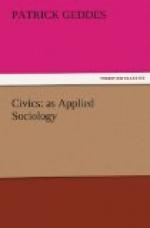Thus even numismatics revives from amid the fossil [Page: 100] sciences. For from this to our own common coinage, or notably to that of France, America, Switzerland, etc., the transition is easy, and still better to that of the noblest civic past, both classic and mediaeval. Without pursuing this further here my present point is gained, if we see, even in the everyday local details of work and people, the enduring stamp, the inextinguishable promise, of the flowering of our everyday industries and schools into worthier ideals than they at present express, and of the fruition of these in turn upon nobler heights of life and practice. It expresses the essential truth of the popular view of the city; that in terms of the formula—People ... Affairs ... Places—above referred to (page 69). It also explains the persistent vitality of this view, despite its frequent crudity, and lack of order in detail, in face of the more scientific treatment here at first employed, that in the elementary geographic order—Place ... Work ... People. For though this objective order be fundamental, it is the complementary subjective evolution which throughout history has ever become supreme; so that our scheme must combine the outward geographic presentment with the inward psychological one. This may be graphically expressed by changing the order of presentment from that used hitherto:—
Town | City City | Town -------------------- to ---------------------- School | Cloister Cloister | School
P—FORECAST OF CITY DEVELOPMENT. SPECIAL AND GENERAL
The dual and four-fold development of the city, as above sketched, is by no means far advanced in most of our present towns or cities, which have obviously but scanty expression of the ideas shadowed forth for the modern equivalents of cloister and cathedral, of academe and acropolis. But this is to say that such towns, however large, populous and rich according to conventional economic standards, are to that extent small and poor, indeed too often little better than cities by courtesy. Yet their further development, upon this [Page: 102] four-fold view of civic evolution, though in principle the same for each and all, has always been, and let us hope may always be, in large measure an individual (because regional) one. For if each human individuality be unique, how much more must that of every city?
In one concrete case, that of Dunfermline, I have already submitted definite suggestions towards the realisation of the civic Utopia, and even architectural designs towards its execution,[13] so that these may at any rate suffice to show how local study and adaptive design are needed for each individual city, indeed for every point of it. It is thus, and thus only, that we can hope to have a city development truly evolutionary, that is, one utilising the local features,




